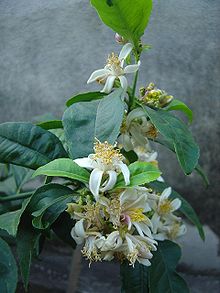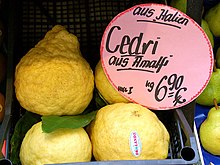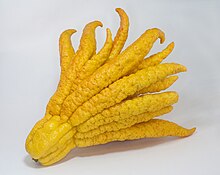Citron Lemon
| Citron Lemon | ||||||||||||
|---|---|---|---|---|---|---|---|---|---|---|---|---|

Fruit of the lemon lemon |
||||||||||||
| Systematics | ||||||||||||
|
||||||||||||
| Scientific name | ||||||||||||
| Citrus medica | ||||||||||||
| L. |
The citron or citron ( Citrus medica ) is a plant from the genus of Citrus Plants in the family of the Rutaceae (Rutaceae). Other names are citron , Median apple , apple from the media , Jews apple , Cedrizitrone , cedar apple , cedar fruit / Cedernfrucht and Zedrat lemon . Citron lemons are considered to be the first citrus fruits grown on the European continent.
Originally from Southeast Asia, it is now mainly grown in Calabria , Sicily , Morocco , Crete , Corsica and Puerto Rico . Most of it is processed into lemon peel .
Surname
The medica in the scientific name refers to the historical land of media . In Italian, the fruit is referred to as cedro (derived from the Greek kedrómêlon , "cedar apple" in relation to the cedar-like smell of the lemon ) and thus has the same name as the cedar . The lemon was the first citrus fruit to be introduced to Europe . The lemon and, indirectly, the cedar, gave the citrus fruits their name . Both the German name Zedrate and the German word lemon are derived from the Italian name cedro , which is also easily recognizable in cedar bread , a pastry with lemon peel . Lemon originally referred to the cedar in the German language, but was later transferred to the lime ( Citrus × limon ) in German and French , a cross between the citron and the bitter orange . In other languages such as English citron is still citron , while the lemon with from the Arabicليمون / laimūn borrowed word lemon .
description
The shrub or small tree forms an irregularly shaped crown. The plant is relatively short-lived and only forms light wood. Young twigs are angular and reddish in color, they are covered with short, thick thorns in the leaf axils .
The leaves are oval, with a blunt tip and a rounded or wedge-shaped base. The leaf margin is serrated. The petiole is short, not or only slightly widened. The leaf blade is only indistinctly separated from the petiole.
The fragrant flowers are in little-flowered inflorescences in the leaf axils. The flower buds are reddish, the petals are white on top and reddish on the underside. About 30 to 40 (60) stamens are present. The ovary is cylindrical and graduates into the pen over. Sometimes the style remains on the ripe fruit. Part of the flowers are functionally male with stunted ovaries.
The fruits with irregular, bumpy, very thick skin can be up to 25 cm long and 4 kg in weight. They are oval in shape, often with a protuberance on the tip, as is known from the lemon . The outer shell is yellow and fragrant when ripe, underneath is the thick white mesocarp . The inside of the fruit is divided into ten to 13 segments, the light green pulp can be sweet or sour, but only takes up a small part of the fruit. The seeds are smooth, pointed at one end, and white inside. They each contain only one embryo.
The number of chromosomes is 2n = 18.
history
Lemon lemons were the first citrus fruits to be grown on the European continent. They were introduced by Jewish migrants who, after the conquest of Jerusalem in AD 70, settled in Spain, Greece and Italy, especially in Calabria . It was not until the Arab conquests in the 9th century that Arab settlers also brought bitter oranges and lemons to the conquered European regions.
origin
Originally, the citron, one of the three original types of citrus fruits alongside grapefruit and tangerine, comes from Assam at the foot of the Himalayas. Assam, with its mild climate and large amounts of rainfall , offered these plants ideal growing conditions. To grow outside of this region in hotter and drier areas, the plant needs human care. The garden historian Helena Attlee says it is astonishing that the plant was initially grown in an ever larger area in China and India : the fruits, with their thick skin and little acidic juice, are hardly edible, the wood is neither suitable as firewood nor as a building material Plant is sensitive and hardly casts any shade. However, in the words of Attlee, it has the almost supernatural quality of bearing abundant flowers and golden fruits of impressive size at the same time. Everything about her smells: the dark green leaves, the flowers, the fruits and even the wood. These remarkable characteristics led to the fact that it was accorded great symbolic importance.
The citron is mentioned in the Vedas , a collection of sacred things, before the 8th century BC. Mentioned texts written in Sanskrit . There it is associated with the Indian Kubera , the Vedic god of wealth, merchants, traders and the treasures of the earth. Because of this attribution, and probably because of the size of the fruit and its golden color, the lemon became a symbol of prosperity. The lemon reappears in a faded ceiling painting in one of the Ajanta caves . The caves were created during the Vakataka dynasty in the 5th century and in one of the caves scenes from the life of Buddha alternate with depictions of flowers and fruits.
Antiquity
When in the 4th century BC When Alexander the Great conquered the Achaemenid Empire , the citron was already widespread there. In his wake, Greek scholars understood the peculiarities of the conquered regions, including the plants cultivated. They described the lemon as a " Median apple". The collected records came after Alexander's death in 323 BC. BC not to Greece, but remained in the archives of Babylon . The ancient Greek naturalist Theophrastus used it as one of the sources for his natural history of plants , which dates back to around 310 BC. BC originated. In Book IV, Chapter IV, he mentioned the citron, which he called the Persian fruit, and recommended it for repelling moths. Theophrast, who probably never saw lemon lemons himself and always emphasized that his knowledge came from second or third hand, has been handed down that the citrus lemon was classified as inedible in the cultivation area at that time. However, their juice was considered to be an antidote to poisoning, as it caused vomiting when mixed with wine.
The Roman writers who, such as Pliny the Elder , commented on the plant world, limited themselves for four centuries to reproducing Theophrastus' hints and apparently did not know the plant firsthand. The first Roman writer to break with this tradition was Palladius : in his work Opus agriculturae , written towards the end of the 4th or beginning of the 5th century , he devoted a chapter to citronate lemons. There he gave detailed information about their care, which he grew on his own citrus plantations in Sardinia and near Naples. In the collection of Roman recipes De re coquinaria , which is ascribed to an Apicius and in its traditional version from the 3rd or 4th century AD, a sauce recipe is described in which lemon peel with mint and fennel in a broth is used. However, there are already indications that citronate lemons became increasingly popular in the Roman Empire: The deeds of the ancient hero Heracles are depicted on a series of bronze drachmas from the reign of the Roman emperor Antoninus Pius (138 to 161 AD) ; lemon-shaped fruits symbolize the golden apples of the Hesperides . Since the lemon was still unknown, it must be citron lemons.
Modern times

Gold-colored citrus plants also had this meaning in the renaissance gardens of wealthy Italian families. The Medici family's outstanding collection of citrus plants, dating back to 1537, was when Niccolò Tribolo began to lay out the gardens of the Villa Medici in Castello , using citrus plants to establish a connection between the Medici family and the heroic ones Underline the virtues of Heracles.
The distinction between citron lemons, oranges and lemons that is customary today began in the Baroque period. In 1646, the Jesuit and botanist Giovanni Baptista Ferrari published an inventory of the citrus plants cultivated at the time with Hesperides, sive, De Malorum aureorum cultura et usu (Hesperides, or, the cultivation and use of golden apples). Instead of building on ancient texts, Ferrari, supported by his friend Cassiano dal Pozzo, had sent a questionnaire to citrus fruit growers all over Italy asking for information about the name of the plant, the origin of the name, the appearance of the tree, the leaves and the flower and requested the fruit and its use. In its evaluation, Ferrari then divided citrus plants into three clearly differentiated categories: lemon lemons, lemons and oranges.
use
Ritual meaning
Judaism

The Jewish migrants who settled on the southern coast of Europe after the conquest of Jerusalem in AD 70, introduced the citron there because it has a ritual meaning during the Feast of Tabernacles . The citron heard as so-called Etrog to which the third book of Moses 23.40 EU prescribed fixed Strauss, who made palm branch ( lulav ), myrtle (Hadassim), Bach pasture is formed (aravot) and Paradise apple (etrog). The latter is literally referred to as the “fruit of the Hadar tree”, referred to as the Etrog in the Babylonian Talmud , Tract Sukka 34, and traditionally identified with the apple of Paradise, from which Adam took. Since their exile in Babylon (597–539 BC), Jews had known the citronate lemon. As a symbol of the religious and national unity of the Jews, it appears on numerous frescoes, mosaics, tombs and ritual objects from the 1st century BC. Chr. On.
The fruits used as etrog must not come from a grafted tree and must be without any defects: They must not have any traces of insect damage and must be of uniform color.
The different groups within Judaism use different varieties of the citron as an etrog, the garden historian Attlee speaks of at least 12 clearly distinguishable varieties. The determination is made by the respective Posek . The Lubavitch Jews , a Hasidic group within Orthodox Judaism , use the Citrus Media 'Diamante' as an etrog on the instructions of their Rebbe Menachem Mendel Schneerson . This variety grows exclusively along a 40-kilometer coastal strip along the northern Calabrian coast between Tortora and Belvedere Marittimo . The trees are harvested twice a year. The harvest time, which takes place around August, is used almost exclusively for the Feast of Tabernacles (Sukkot). During this time there are numerous representatives of this faith in northern Calabria, who monitor that the fruits come from plantations that meet the requirements and buy suitable fruits for the Lubavitch communities that are today all over the world. Only a very small part of the harvest meets the high demands placed on the Etrog . Flawless fruits that meet the requirements are traded for prices between € 25 and € 250.
Buddhism
In Buddhism, the lemon lemon also has a ritual meaning: In Buddhist temples it is used as an offering. Traditionally, Citrus medica var. Sarcodactylis , also called Buddha's hand in German , is the variety preferred by the Buddha. It is characteristic of this variety that the individual fruit segments are individually surrounded by the skin. This results in a fruit that vaguely resembles a hand. Due to their shape, the fruits are decorative, have a pleasant fragrance, but do not contain any juicy pulp. The specimens that remind of a closed hand are particularly appreciated, as they remind of the position of the hand during a prayer. In China, the Buddha's hand symbolizes happiness, contentment and a long life. It is also a traditional New Year gift.
Food
The sparse pulp is rarely used fresh because it tastes very bitter. The yellowish-green to golden-yellow peel, on the other hand, is processed into lemon peel , jam and liqueur . The essential oil is also used in perfume production.
The base material for a soft drink called Cedrata, which is widespread in Italy, is extracted from the cedro .
In southern Italy, especially in Sicily, the locals use the cedro to make a refreshing, spicy dish. For this Cedri Carpaccio ( Insalata di Cedri ), the whole, thoroughly washed fruit is cut into thin slices and marinated in salt, sugar, pepper and olive oil and served with rocket and grilled prawns as a starter, for example .
sorts
Within the species, the following varieties are of particular importance:
- Citrus medica var. Sarcodactylis ( give a wiki. "Meat-fingered") Hoola van Nooten , Swingle , Citrus medica var. Digitata , in different languages and Buddha's Hand ( Chinese 佛手柑 , japanese 仏の手 , Vietnamese Phật Thủ ) Fruit called.
- Citrus medica "Diamante": In addition to its use as an etrog by Lubowitscher Jews, the well-known citron is made from its peel through fermentation, sugar-coating and drying.
The following previously considered varieties are currently assigned to other species:
- Citrus medica var. Acida ( Roxb. ) Hook. f. : Is now Citrus × aurantiifolia ( Christm. ) Swingle .
- Citrus medica var. Limon L. : Now Is Citrus × limon (L.) Burm. f.
literature
- Helena Attlee: The Land Where Lemons Grow: The Story of Italy and its Citrus Fruit. Penguin Books, London 2015, ISBN 978-0-14-196786-8 .
- W. Reuther, HJ Webber, LD Batchelor (Eds.): The Citrus Industry. 5 volumes. University of California , Berkley 1967–1989 ( available online ; on citrus lemon see. Volume 1, Chap. 3, The Botany of Citrus and Its Wild Relatives: Citrus L. , Chap. 4, Horticultural Varieties of Citrus : Citron ( Citrus medica L .) ).
- Carsten Schirarend: The golden apples. Association of the Natural Science Museums of Berlin V., Berlin 1996, ISBN 3-926579-05-6 .
Web links
- Citron Lemon (Citrus medica L.) at GRIN Taxonomy for Plants (English)
- Data sheet - Lemon lemon from Steffen Reichel
Individual evidence
- ↑ a b c d e Helena Attlee: The Land Where Lemons Grow. P. 177.
- ↑ a b Helmut Genaust: Etymological dictionary of botanical plant names. 3rd, completely revised and expanded edition. Birkhäuser, Basel / Boston / Berlin 1996, ISBN 3-7643-2390-6 , pp. 159-160.
- ↑ Citrus medica at Tropicos.org. In: IPCN Chromosome Reports . Missouri Botanical Garden, St. Louis
- ↑ a b c d Helena Attlee: The Land Where Lemons Grow. P. 180.
- ↑ a b Helena Attlee: The Land Where Lemons Grow. P. 181.
- ↑ Theophrastus, Sir Anthony Hort (ed.): Inquiry into Plants and Minor Works on Odors and Weather Signs . tape 4, § 4 . Harvard Univ. Press, Cambridge / Mass. 1961.
- ↑ Helena Attlee: The Land Where Lemons Grow. P. 182.
- ↑ a b c Helena Attlee: The Land Where Lemons Grow. P. 184.
- ↑ Helena Attlee: The Land Where Lemons Grow. P. 11.
- ↑ Helena Attlee: The Land Where Lemons Grow. P. 35.
- ↑ Helena Attlee: The Land Where Lemons Grow. P. 37.
- ↑ Helena Attlee: The Land Where Lemons Grow. P. 189.
- ↑ Helena Attlee: The Land Where Lemons Grow. P. 190.
- ↑ Helena Attlee: The Land Where Lemons Grow. P. 192.
- ↑ Helena Attlee: The Land Where Lemons Grow. P. 197.
- ↑ Buddha's hand. In: Melissa's Produce. Retrieved February 22, 2016 .
- ↑ Cedrata - Lemon Lemon Drink. In: Authentisch-Italienisch-Kochen.de. Retrieved on February 13, 2020 (German).







